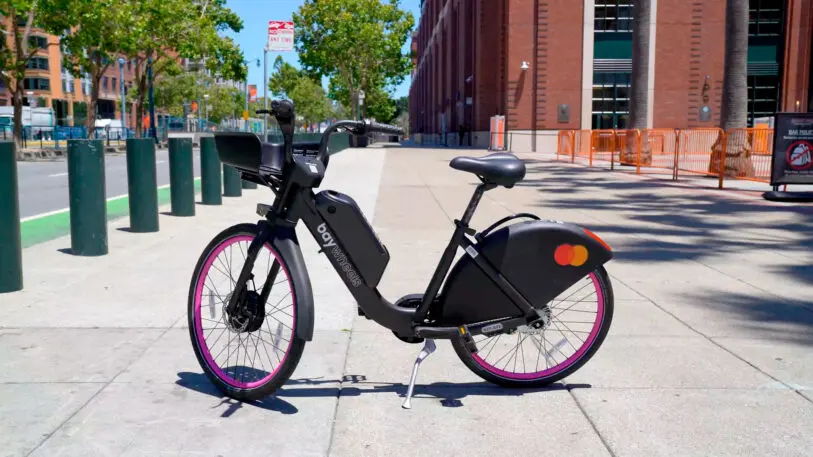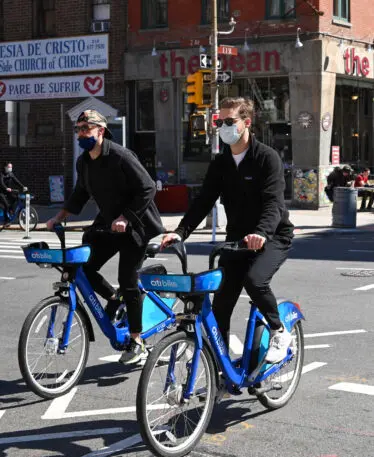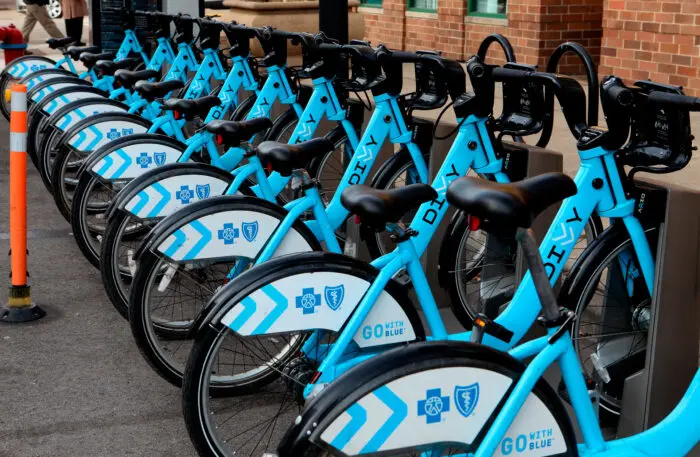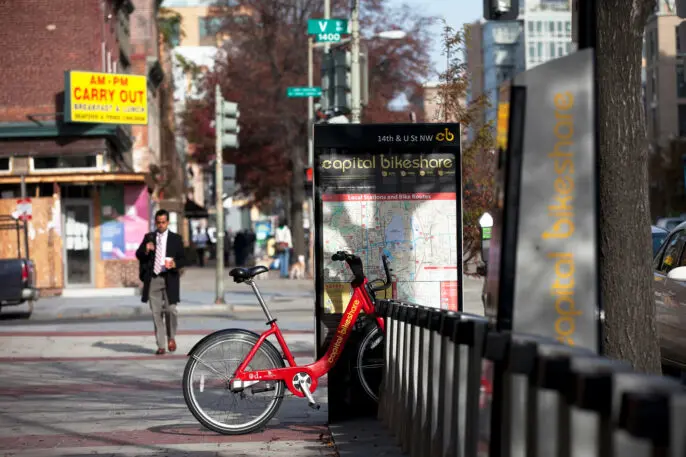By American standards, Minneapolis is a bicyclist’s paradise. With some 200 miles of bike lanes and trails, the city uses special equipment to keep them clear of snow and ice during winter. The City of Lakes consistently places near the top of lists ranking the best U.S. cities for biking.
With two-wheeled transportation so popular, it’s no surprise that Minneapolis’s bikeshare system, known as Nice Ride, was among the first to launch in the U.S. 13 years ago. Usage dipped a bit during the pandemic, but Nice Ride still provided more than 260,000 trips last year.
So it came as a shock when Racket, a local news platform, reported in March that Nice Ride would shut down. The reason: Blue Cross Blue Shield declined to renew its $3 million annual title sponsorship, which left a gaping hole in Nice Ride’s budget. Lyft, the system’s operator, was unable to find a way to fill it, and state and local officials declined to provide a backstop. That was the end of docked bikeshare in Minneapolis.
“The city is disappointed that we’re losing Nice Ride,” said Dillon Fried, the city’s interim mobility manager. “We wish they were still here.”
At its surface, the Bay Area’s bikeshare story looks similar. Bay Wheels, the regional service for San Francisco, Oakland, San Jose, and nearby municipalities, is also operated by Lyft. Like Nice Ride, Bay Wheels saw usage drop after the pandemic as many people worked from home. Both systems also encountered unexpected financial difficulties: Although Bay Wheels didn’t have a title sponsor, a recent spate of vandalism has increased its maintenance costs.
But there is one fundamental difference. In the Bay Area, local leaders have allocated $16 million to safeguard Bay Wheels’s future. “Unlike Minneapolis, we’re unwilling to lose the bikeshare provider,” said Andrew Fremier, executive director of the Metropolitan Transportation Commission, which arranged the investment in Bay Wheels. “We weren’t willing to have bikeshare go dark.”
The new funding will help Lyft upgrade Bay Wheels’s infrastructure and reduce membership costs.

Why are the Bay Area’s leaders revitalizing bikeshare, while Minneapolis officials are resigned to losing their system? The answer goes back to bikeshare’s initial emergence in the U.S. 10 to 15 years ago. At the time, many cities promised that their systems would operate without public subsidy, with users and sponsors covering costs. That approach diverged from European cities, but it seemed to work out—at least for a while.
The 2010s saw a veritable bikeshare boom, with urban residents across the U.S. gaining access to a uniquely healthy, green, affordable, and space-efficient form of mobility. Curbed writer Alissa Walker dubbed bikeshare the biggest transportation success story of the decade.
But times have changed. Expecting bikeshare to operate without subsidies may have been politically necessary a decade ago, but it’s now starting to look like an original sin. After all, it’s hard to understand why the survival of a thriving system like Nice Ride should depend upon corporate largesse. And with many dense neighborhoods already well-served, it’s not clear that bikeshare operators can afford to expand further into low-income and sparsely populated communities. There are opportunity costs, too: Without subsidies, bikeshare systems will struggle to capitalize on the soaring popularity of e-bikes.
What’s the big problem with putting public money into bikeshare, anyway? After all, most policymakers recognize the need to subsidize transit, due to the expense of operation and the societal benefits that buses and trains provide by reducing congestion and emissions (not to mention providing low-income residents with essential mobility). But bikeshare checks all the same boxes. So why have U.S. cities resisted subsidizing it?
As Minneapolis’s experience reveals, this is not a theoretical question. If cities will not put money into subsidizing their system, they should be prepared to lose it.

Bikeshare was the hot new thing in urban mobility when it arrived on American streets in the early 2010s. Early boosters included urbanist luminaries like Gabe Klein, who launched systems in Washington, D.C., and Chicago when he ran those cities’ transportation departments, and Janette Sadik-Khan, who oversaw the creation of Citi Bike in New York City. Bikeshare’s novelty in the U.S., along with its success in foreign cities like Montreal and Lyon, conferred a touch of global cool.
“To be a world-class city, you need to have a bikeshare program,” said Bill Dossett, the longtime executive director of Nice Ride, seven years ago.
Beyond its hip image, bikeshare offered plenty of upside for city residents—even if they would never use it. Most obviously, bikeshare could replace car trips, in the process reducing emissions and traffic jams. The new systems could also compliment transit by helping residents reach stations, while their modest cost (Capital Bikeshare memberships were initially just $50 per year) made them affordable for low-income residents.
Docked bikes might even serve as a gateway drug for two-wheeled commuting; one survey found that bikeshare led people in the Washington, D.C., area to ride their own bikes more often. (I’m living proof of this phenomenon. In 2012, I wobbled through my first Capital Bikeshare ride; within a few months I got rid of my car and bought a bike that became my main mode of transport.)
For those still on the fence, early bikeshare boosters offered one additional talking point: The new systems would not require an ongoing contribution from local governments. In a 2015 op-ed, Klein described his initial bikeshare pitch to D.C. Mayor Adrian Fenty: “[Fenty asked] ‘Could it break even or be profitable operationally?’ I said, ‘I think so,’ and aimed to make that happen.”
“At the time, there really wasn’t political will to allocate money to bikeshare,” said Scott Kubly, who worked closely with Klein to launch both Capital Bikeshare in D.C. and Divvy in Chicago and later ran the Seattle Department of Transportation. “If you were a city transportation official, you had to figure out how to make it happen. Bikeshare wouldn’t have existed without that entrepreneurialism.”
Sadik-Khan, who launched Citi Bike in New York City, saw her no-subsidies approach as a national model. In a 2016 interview she predicted, “You’re going to see mayors looking to install these new systems, not having to use their public funding to do it, but utilizing the private sector to be able to double down on that kind of investment.”
Instead of receiving local funding, many systems relied on multimillion-dollar sponsorships from companies like Citibank (New York City) and Blue Cross Blue Shield of Massachusetts (Boston) to keep them afloat. According to a report by the North American Bikeshare & Scootershare Association, in 2019 rider fees contributed just over half of revenues for an average bikeshare system, with sponsorships providing 30% and public subsidies just 12%. In some big cities, bikeshare actually contributes money to public coffers. In Chicago, for instance, Lyft is contractually obligated to pay the city at least $6 million annually to operate Divvy.

Although many U.S. city officials shied away from funding bikeshare, it’s not clear that they should have. After all, riding a shared bike generates myriad benefits for all city residents, such as cleaner air and less congestion. Economists call these effects “positive externalities,” and consider them to be justification for public subsidies.
Indeed, Europe has embraced bikeshare funding in a way that the U.S. has not. As a result, rides in American cities can be stunningly expensive by European standards. For example, a visitor taking a 30-minute pedal bike ride would pay 1 euro ($1.09) in Brussels and 1.65 pounds ($2.06) in London, but $3.49 in San Francisco, $4.49 in New York City, and $6.10 in Chicago.
Even with minimal public support, American bikeshare flourished during the 2010s. According to the National Association of City Transportation Officials, docked systems nationwide provided some 40 million trips in 2019. In New York City alone, Citi Bike riders took almost 20 million rides in 2020—more than all transit trips that year in Sacramento or Cleveland.
And bikeshare’s projected benefits turned out to be real: One study found that Capital Bikeshare reduced traffic congestion in D.C. neighborhoods by 4%; another researcher estimated that every ride that replaced a car trip avoided a pound of carbon emissions. Even infamously bike-wary small-business owners were supportive: 70% of those in the D.C. area said that bikeshare enhanced their neighborhood.
But beneath the surface, bikeshare management grew more complex over the past decade. Many systems began by launching in dense downtown areas where it was easiest to operate profitably. To expand further, systems would have to venture into sparsely populated or less-affluent areas where revenues would not cover costs.
Meanwhile, the rise of dockless scooters brought new competitors for docked systems. And since bikeshare is less novel today than it was a decade ago, big-dollar corporate sponsorships may be harder to secure. If so, Minneapolis is unlikely to be the last city unable to replace a title sponsor. (Lyft declined to say whether bikeshare is currently profitable for the company.)

And then there are e-bikes, the wildly popular vehicles that have outsold electric cars in the U.S. Many of the bikeshare systems that introduced e-bikes have found them to be a sensation—but their popularity comes at a cost. “At peak times, Citi Bike’s e-bikes are used up to 15 times per day, compared to 4 to 5 times per day for pedal bikes,” said Laura Fox, who recently left her role as Citi Bike’s general manager.
“Batteries therefore have to be swapped out once or more every day,” Fox says, with staff shuttling from station to station to replace dead batteries with new ones. Beyond the cost of procuring the e-bikes themselves, the ongoing process of replacing spent batteries requires labor, time, and money, constraining operators’ ability to deploy them.
Happily, there is a solution. Electrifying bikeshare stations would allow electric bikes to be charged automatically before the next rider unlocks them. “If we have 20% to 30% of stations electrified, we can reduce battery swaps by 75% to 80% in a big city like New York,” said Caroline Samponaro, Lyft’s head of transit and micromobility policy. “That would eliminate a major cost driver.”
According to Lyft, electrifying a station can cost around $100,000, suggesting that adding electricity to 25% of Citi Bike’s 1,700 stations would total roughly $50 million. Expecting Lyft to cover such expenses alone seems dicey, especially given its tanking share price (which is down more than 60% in the past year) and the limited time horizon of many bikeshare operating contracts.
Some cities have concluded that bikeshare’s challenges—as well as electrification’s tantalizing potential—warrant new public investment. Boston Mayor Michelle Wu recently proposed contributing $1.4 million to add e-bikes to the local Bluebikes network. In Austin, the city is seeking state funding to expand MetroBike, the system it runs in partnership with the local transit agency.
And then there’s the Bay Area’s new and precedent-breaking $16 million investment in Bay Wheels. “Bikeshare doesn’t appear to be a moneymaker without a subsidy, just like transit,” said MTC’s Fremier. “But all the cities in this region see Bay Wheels as a benefit.”
The new funds will help replace the system’s aged equipment, procure new e-bikes, and electrify 8 to 10 stations (the price of Bay Wheels membership will also drop by $19 per year). Fremier believes that offering public funds was a necessary move: “Lyft came to us and said they couldn’t keep going through the losses that they’re having, and we validated it with financial information they gave us.”
Kubly, who helped bring bikeshare to D.C. and Chicago over a decade ago, applauds the city leaders who are showing new willingness to cut checks. “Bikeshare today cannot go without subsidy if you want to have any semblance of a public policy goal,” he said. “If you want it in low-income areas or if you want it to be price-competitive with a cab, you’re probably going to need to subsidize it.”
If there is ever a time for cities to start funding bikeshare, now seems like the right time to do it. Not only are e-bikes positioned to fuel a new era of bikeshare growth, but the 2021 passage of the bipartisan Infrastructure Bill opened new spigots of federal funding that could help cover the costs of electrifying stations, including the Charging and Fueling Infrastructure and National Electric Vehicle Infrastructure programs. (It doesn’t hurt that the person overseeing billions of dollars in EV infrastructure implementation is none other than early bikeshare believer Gabe Klein.)
Even without federal dollars, the funding necessary to shore up bikeshare’s future need not overwhelm city budgets. As a point of comparison, the cost of electrifying 25% of Citi Bike docking stations is about as much as New York City spends annually to subsidize its ferry services—which transport barely a sixth as many people.
Yes, the provision of subsidies breaks a decade-plus expectation that bikeshare should pay for itself. But given these systems’ manifold societal benefits, as well as both the challenges they face and their current potential to scale, it’s time to abandon a policy that has outlived its usefulness.
Lucas Peilert provided research assistance for this article.
Recognize your brand’s excellence by applying to this year’s Brands That Matter Awards before the early-rate deadline, May 3.
